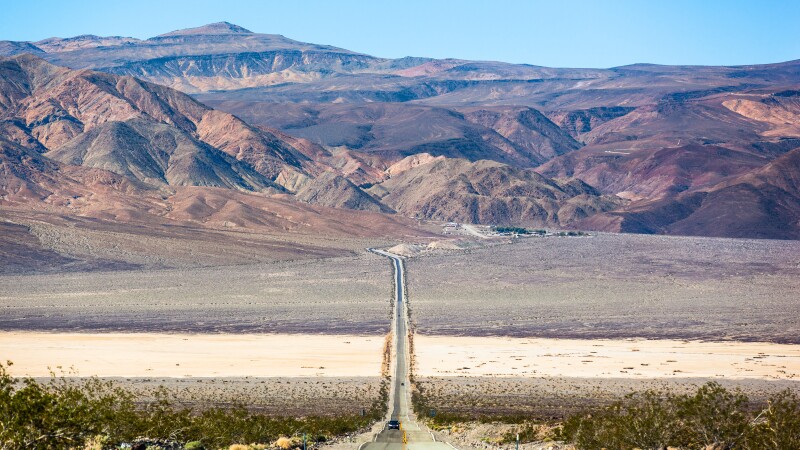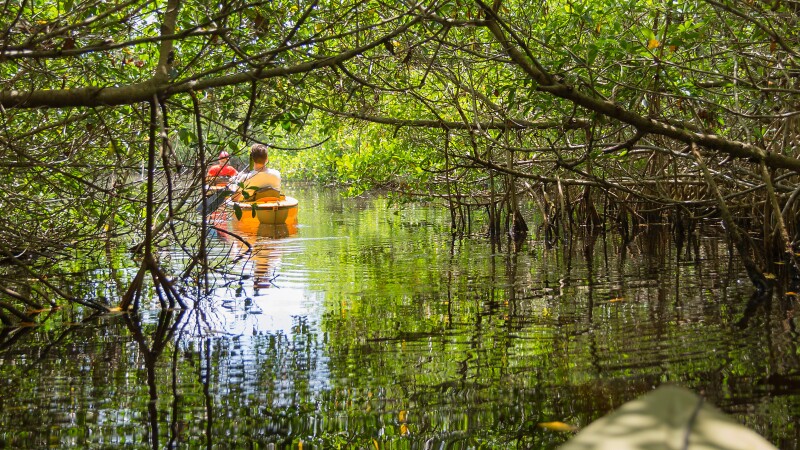They say timing is everything, and the maxim rings especially true when planning your next trip to a national park. Whether you’re looking to avoid crowds and extreme heat or your goal is to catch seasonal phenomena like blooming wildflowers or the northern lights, consider this your cheat sheet to the parks that show off their best colors in the spring.

In Death Valley National Park, wildflower superblooms can occur from February to July, depending on rainfall in the area.
Photo by Radoslaw Lecyk/Shutterstock
Death Valley National Park
California and Nevada
Why spring? You’ll beat the heat.
Famous for being considered the hottest place on Earth, Death Valley National Park often reaches temperatures of 120 degrees Fahrenheit and higher in the summer. Happily, springtime highs in the area hover in the 70s, 80s, and 90s—a much more comfortable climate for exploring the expansive salt flats of Badwater Basin or searching for Racetrack Playa’s mysterious “sailing rocks.”
Stay: The 93-year-old Oasis at Death Valley is back in the bloom of youth after a multimillion-dollar refurb that wrapped up in 2018. All 66 rooms were redone, and the historic spring-fed pool (naturally 87 degrees year-round) now features cabanas, a bar, and a café. There are also 22 casitas on the property.

Olympic National Park encompasses several different ecosystems, including glacier-capped mountains, old-growth rain forests, and wild Pacific coastline.
Photo by Jon Beard/Shutterstock
Olympic National Park
Washington
Why spring? It’s an optimal time to spot wildlife.
In the spring, gray whales and numerous species of bird migrate to Olympic National Park. Bears also come out of hibernation, and rain-forest creatures like banana slugs, frogs, and giant green anemones thrive in the heightened humidity. Look for deer, bobcats, mountain lions, bald eagles, and elk on the park’s 611 miles of hiking trails—but exercise caution and always keep your distance, of course.
Stay: Located within the national park, Sol Duc Hot Springs Resort offers a poolside massage that is a soporific complement to a posthike soak in the rustic resort’s hot-spring pools.

Cooler temperatures and fewer crowds make spring an ideal time to visit the hugely popular Grand Canyon National Park.
Photo by Elena Larkina/Shutterstock
Grand Canyon National Park
Arizona
Why spring? You’ll find it far less crowded.
Summer is peak season at Grand Canyon National Park, which means heavy traffic on popular nature walks and crowding at prime viewpoints should be expected then. To avoid the masses, hit the sweet spot between spring break and the start of summer vacation (from late March to early May). Head for the Grand Canyon West area to peer down at this world wonder from the 4,000-foot-high Skywalk bridge.
Stay: Reserve one of 44 cabins at Hualapai Ranch, located on the West Rim. Nearby, you can fly over Quartermaster Canyon on the Zipline at Grand Canyon West, which can hit speeds approaching 40 mph.

Saguaro National Park consists of two sections situated around Tucson, Arizona.
Photo by Anton Foltin/Shutterstock
Saguaro National Park
Arizona
Why spring? To see the wildflowers.
Only found in Arizona’s Sonoran Desert, the saguaro cactus flourishes in Saguaro National Park, which is home to approximately 1.6 million of the tree-like cacti. In addition to favorable weather and extended daylight hours, the month of April also presents the chance to see the saguaro cacti’s white blossoms (Arizona’s state flower), as well as a riot of other desert wildflowers.
Stay: Tucked in the foothills of the nearby Santa Catalina Mountains, El Conquistador Tucson, a Hilton Resort features an 18-horse stable, a salsa garden, and firepits, three golf courses, and six pools.

Yosemite National Park is famous for its towering waterfalls, granite cliffs, ancient sequoias, and valley meadows.
Photo by Mike Ver Sprill/Shutterstock
Yosemite National Park
California
Why spring? For the epic waterfalls
Yosemite National Park is home to thousands of waterfalls, including Yosemite Falls (one of the tallest in North America) and Bridalveil Fall. Horsetail Fall is famous for the annual “firefall”, when it glows electric-orange at sunset in mid- to late February. But thanks to melting snow in late April and early May, all the cascades are at their peak throughout spring.
Stay: The renovated Ahwahnee Hotel (formerly the Majestic Yosemite Hotel) sits near popular spots such as Yosemite Falls, Half Dome, and Glacier Point. It’s also listed as a National Historic Landmark on the National Register of Historic Places. (Queen Elizabeth stayed here on her visit to Yosemite in the 1980s.)

Gates of the Arctic National Park and Preserve is situated under the “aurora oval”—a ring-shaped zone where aurora activity is concentrated.
Photo by Western Arctic National Parklands/Flickr
Gates of the Arctic National Park & Preserve
Alaska
Why spring? You can witness the northern lights here at this time of year.
Sitting entirely above the Arctic Circle, Gates of the Arctic National Park & Preserve is a prime spot for northern-lights viewing in Alaska’s untamed wilderness. The natural spectacle can be seen in the area from late August through mid-April, but a visit between winter and early spring offers the chance to partake in snowy activities like dog-sledding and cross-country skiing.
Stay: Book a room at Bettles Lodge, a remote outpost set directly underneath the “aurora oval” in the foothills of northern Alaska’s Brooks Range.

The UNESCO-recognized Everglades National Park is the third largest national park in the United States.
Photo by mariakraynova/Shutterstock
Everglades National Park
Florida
Why spring? You’ll avoid the mosquitoes.
During summer, mosquitoes, rain, and high humidity are no joke in the country’s largest tropical wilderness and the most popular of Florida’s national parks. But from December through May, the dry season in Everglades National Park brings fewer pests and prime weather for adventures. In springtime, a guided canoe or kayak trip is one of the best ways to spy tropical birds, West Indian manatees, and, of course, alligators.
Stay: The family-owned Ivey House has been leading eco-paddling kayak excursions into Everglades National Park for almost 40 years. Morning, midday, and twilight tours into the mangroves are guided by National Park Service–certified naturalists.
This article originally appeared online in April 2018; it was updated on March 12, 2020, to include current information.











